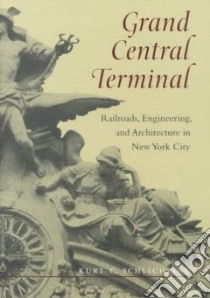Grand Central Terminal - 9780801865107
Un libro in lingua di Schlichting Kurt C. edito da Johns Hopkins Univ Pr, 2001
- € 31.80
- Il prezzo è variabile in funzione del cambio della valuta d’origine
Grand Central Terminal, one of New York City's preeminent buildings, stands as a magnificent Beaux-Arts monument to America's Railway Age, and it remains a vital part of city life today. Completed in 1913 after ten years of construction, the terminal became the city's most important transportation hub, linking long-distance and commuter trains to New York's network of subways, elevated trains, and streetcars. Its soaring Grand Concourse still offers passengers a majestic gateway to the wonders beyond 42nd Street.
In Grand Central Terminal, Kurt C. Schlichting traces the history of this spectacular building, detailing the colorful personalities, bitter conflicts, and Herculean feats of engineering that lie behind its construction. Schlichting begins with Cornelius Vanderbilt—"The Commodore"—whose railroad empire demanded an appropriately palatial passenger terminal in the heart of New York City. Completed in 1871, the first Grand Central was the largest rail facility in the world and yet—cramped and overburdened—soon proved thoroughly inadequate for the needs of this rapidly expanding city. William Wilgus, chief engineer of the New York Central Railroad, conceived of a new Grand Central Terminal, one that would fully meet the needs of the New York Central line. Grand Central became a monument to the creativity and daring of a remarkable age.
The terminal's construction proved to be a massive undertaking. Before construction could begin, more than 3 million cubic yards of rock and earth had to be removed and some 200 buildings demolished. Manhattan's exorbitant real estate prices necessitated a vast, two-story underground train yard, which in turn required a new, smoke-free electrified rail system. The project consumed nearly 30,000 tons of steel, three times more than that in the Eiffel Tower, and two power plants were built. The terminal building alone cost $43 million in 1913, the equivalent of nearly $750 million today.
Some of these costs were offset by an ambitious redevelopment project on property above the New York Central's underground tracks. Schlichting writes about the economic and cultural impact of the terminal on midtown Manhattan, from building of the Biltmore and Waldorf-Astoria Hotels to the transformation of Park Avenue. Schlichting concludes with an account of the New York Central's decline; the public outcry that prevented Grand Central's new owner, Penn Central, from following through with its 1969 plan to demolish or drastically alter the terminal; the rise of Metro-North Railroad; and the meticulous 1990s restoration project that returned Grand Central Terminal to its original splendor. More than a history of a train station, this book is the story of a city and an age as reflected in a building aptly described as a secular cathedral.
Informazioni bibliografiche
- Titolo del Libro in lingua: Grand Central Terminal
- Sottotitolo: Railroads, Engineering, and Architecture in New York City
- Lingua: English
- Autore: Schlichting Kurt C.
- Editore: Johns Hopkins Univ Pr
- Collana: Johns Hopkins Univ Pr (Hardcover)
- Data di Pubblicazione: 12 Marzo '01
- Genere: TRANSPORTATION
- Argomenti : Railroad terminals New York (State) New York History Railroad terminals Conservation and restoration New York (State) New York
- Pagine: 243
- Dimensioni mm: 266 x 184 x 25
- EAN-13: 9780801865107


